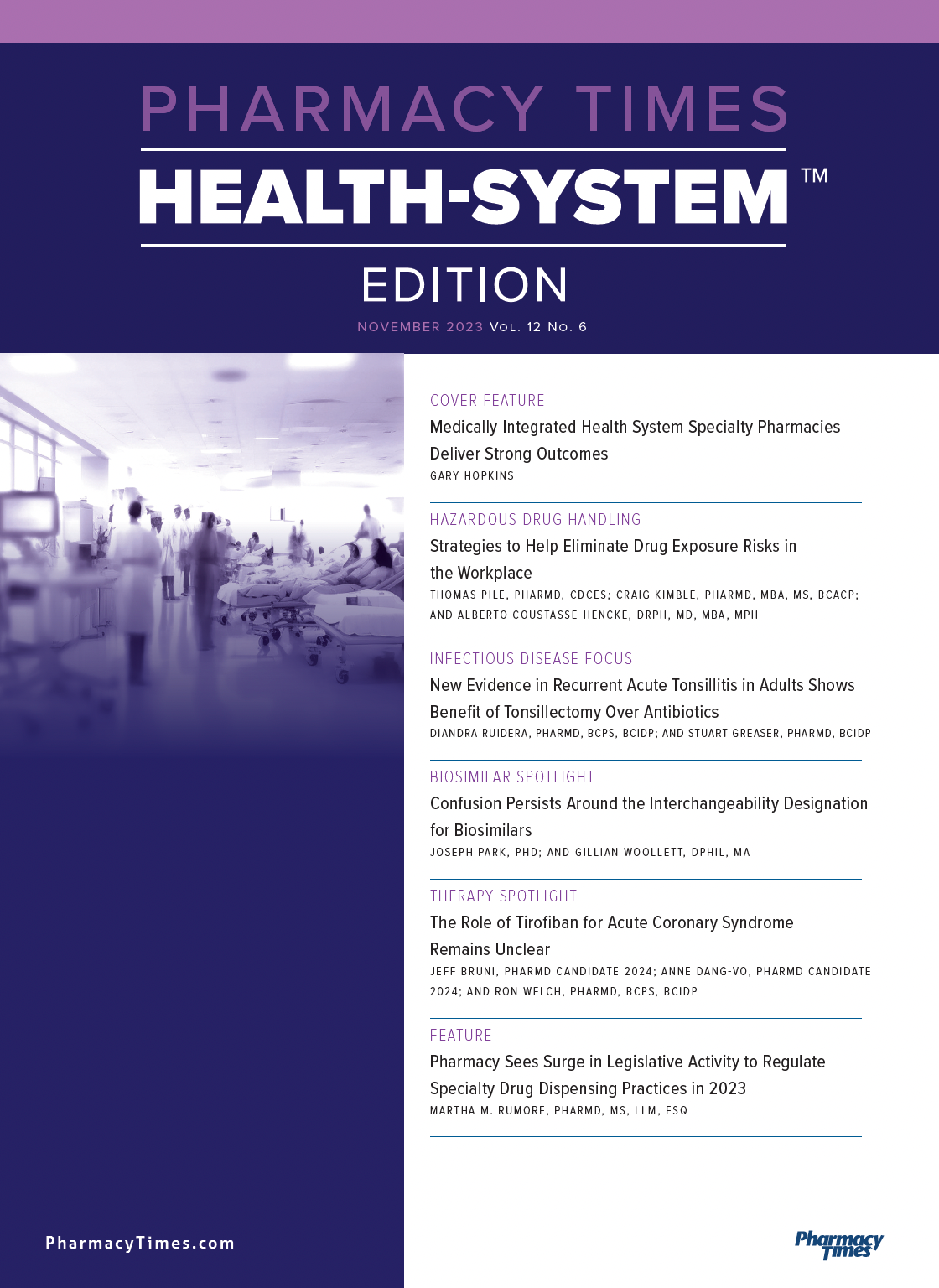Evolution of Health System Specialty Pharmacy to Health System Comprehensive Pharmacy Care
This comprehensive approach is what all stakeholders, especially patients and families, need and deserve from their health care system.
In this issue of Pharmacy Times Health-System Edition, Gary Hopkins, a principal with Blanco + Hopkins & Associates, LLC, a health care public affairs firm based in La Cañada, California, provides an excellent review of the value of health systems–owned specialty pharmacy (HSSP) programs. When implemented effectively, HSSPs bring great value to patients, providers, the health system, and payers by providing outstanding patient-centered and integrated care to patients with complex diseases, and Hopkins’ review discusses how each of these stakeholders can benefit. We have been able to document similar outcomes for a large HSSP at my home institution. In this commentary I argue how important it is for health system pharmacy departments to solve the challenges of expanding this mission to provide comprehensive pharmacy care in a similar patient-centered approach.
Diego Cervo - stock.adobe.com

Several years ago I was attending a small meeting of pharmacy executives. A colleague, Rita Shane, PharmD, FASHP, FCSHP, vice president and chief pharmacy officer at Cedars-Sinai, made an excellent point that I have never forgotten. Shane pointed out that health systems spend millions of dollars every year to make the medication use system as perfect as possible during an acute care hospital admission. We unit dose package every medication and use barcode scanning, smart pumps with dose error reduction systems, automated dispensing cabinets, and high-tech clean rooms to assure safe compounding standards. We use electronic medication administration records, electronic health record ordering systems, order sets and panels, and electronic treatment plans. Additionally, we implement many other interventions and system integrations to do everything possible to get the medications right for the average 6.5 days the patient is in the hospital. For the other 350-plus days of that year, we do almost nothing to assure a safe medication use system in the community. That approach is just not going to meet our value-based population health needs now or in the future. Our obligation to that patient and our commitment to quality care no longer end when the hospital door closes behind them on their way out.
Medication-related outcomes for chronic diseases in the United States are not good. Evidence shows we spend more money each year on dealing with the bad outcomes of medication therapy than we spend on the medications themselves.1 Although this is a complex, multifaceted problem to address, a broken medication use system in the community does not help. Most Americans who need prescription drugs are exposed to a nonintegrated, inefficient, asynchronous, and non–patient-centered system based on a mercantile business model—a model we are so used to as the norm that we don’t really expect anything different. Approximately 75% to 80% of all interventions for chronic diseases involve drug therapy, which is generally self-administered, and yet that critically important element of care is relegated to a professional who normally has no access to meaningful information about the patient. The community pharmacist is usually unaware of diagnoses, laboratory and other diagnostic data, and increasingly other medications they are receiving and has a challenging to nonexistent means of communicating with other members of the patient care team with whom they have no professional relationship. In most settings, if the patient is unable to pay for their medications, they will not receive them. If the patient never picks up their medications (primary nonadherence), there are rarely systems in place to alert the other members of the patient care team. After 14 days, the medication is simply returned to inventory and the prescription claim reversed. Medications that are discontinued by the provider often are not discontinued at the pharmacy.
We also have growing pharmacy deserts in both urban and rural communities, contributing to disparities in health care as they relate to medication access. On top of all this system brokenness, we have pharmacy professionals who are overworked, underresourced, and struggling to just get through the day in many community pharmacies, leading to further deprivation of meaningful direct patient pharmacy care. These horrid work conditions have led to legislation being passed in California, as well as walkouts by pharmacists at major chains in recent weeks.2,3
Payers seem to be increasingly pursuing the lowest net cost at the prescription counter by forcing patients to use multiple pharmacy providers to meet their overall medication needs. Between specialty pharmacies, cost-plus and other discount outlets, mail order, and community pharmacies, patients may be pushed to use multiple providers, leading to no one pharmacist seeing the entire medication profile and what must be a confusing situation for many older patients with chronic illness to manage. This may save money at the claims level, but it certainly is not conducive to optimizing medication-related outcomes and overall costs of care. In this respect, we are really going in the wrong direction.
Providing high-quality, patient-centered pharmacy care in an HSSP environment is relatively easy because it is a resource-rich environment. In large systems, we can embed dozens of clinically trained pharmacists in can use coordinators to manage patient communication, customized delivery plans, and administrative aspects of prior authorization and patient assistance programs. The bigger challenge is, how do we provide a heightened level of pharmacy care for all pharmacy needs for the patients of our health care system? If we really want to improve outcomes on a broad basis, and not only for the 2% to 3% of patients prescribed specialty drugs, it will take a much more complex strategy that uses risk stratification, impact assessment, and highly efficient clinical communication and operational systems to meet our patients’ needs.
We have to convince our provider communities that pharmacy care should be treated like any other referral for care, and that it should matter where their patients are receiving that care in order to improve outcomes and value-based performance. Also, we have to demonstrate to payers and employers that the integrated delivery for patient-centered pharmacy care translates to better drug-related outcomes and lower overall cost of care. Additionally, we must create what I often refer to as the pharmacy easy button. Providers, clinics, patients, and families should have a single point of contact for all pharmacy-related patient needs. Behind the scenes, a comprehensive pharmacy plan should be implemented, including specialty pharmacy, non-specialty pharmacy, home infusion, alternative nutrition support, and durable medical equipment depending on patient-specific needs. This team would have access to all necessary information to handle benefit investigations, prior authorizations, billing, patient assistance programs, charity care, and other administrative details as needed without the provider clinic having to deal with 5 different vendors.
This comprehensive approach is what all stakeholders, especially patients and families, need and deserve from their health care system. Health system pharmacy leaders must figure out how we achieve these goals and document our success in a much more resource-depleted environment than HSSPs represent as a single component of this comprehensive need. High-quality, patient-centered pharmacy care in all environments of care is our responsibility.
About the Author
Curtis E. Haas, PharmD, FCCP, is director of pharmacy for the University of Rochester Medical Center in New York.
References
- Watanabe JH, McInnis T, Hirsch JD. Cost of prescription drug–related morbidity and mortality. Ann Pharmacother. 52(9):829-837. doi:10.1177/1060028018765159
- The Finkel Firm. California law prohibits work quotas on pharmacists. Medium. December 20, 2021. Accessed October 16, 2023. https://medium.com/@The_Finkel_Firm/california-law-prohibits-work-quotas-on-pharmacists-37be6b2f1774#:~:text=Beginning%20in%202022%2C%20a%20new,start%20of%20the%20new%20year
- Goodkind N. Why Walgreens pharmacy workers are walking off the job. CNN. October 10, 2023. Accessed October 16, 2023. https://www.cnn.com/2023/10/10/economy/walgreens-pharmacy-walkouts/index.html

